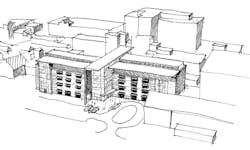10 essential habits of successful architects
1. Sketch. Draw by hand. I know our desks are getting smaller and more crammed with computer monitors, but find a space to sketch. This is an essential communication skill. I admit my sketching has fallen out of practice but it’s something I always strive to do more. Sketching is the most expeditious way to express an idea. I have been in meetings with clients and had colleagues start sketching, to much adulation of the client. Everyone from clients to construction managers to subcontractors [to parents] expect us to be proficient and talented at drawing. That’s what they think we do, so let’s hone it and do more of it.
2. Fellowship. Give back. Advocate for the profession. If you don’t, who will? Join the AIA. Be a part of their re-positioning initiative. Read about the Architecture-Lobby. Join CSI. This profession is evolving and we have to protect our own interests because no one else will. Give back to the next generation of architects. Get involved in student crits. Go to career fairs for your company. I recently visited my alma mater, the University of Illinois. There is something about meeting with the students that re-energizes my nearly jaded perspective on the profession. Their enthusiasm and talent was infectious. It almost lasted THREE DAYS…until the sh!% hit the fan at work again.
3. Deal with Criticism. Let go of ego. All creative professions are susceptible to criticism. Make the project the top priority. It’s better to divorce yourself from an idea so that one is not personally offended. Also, practice criticism so that critique enhances the intent. The advice should help or add value. Give “whys” and suggestions. No one likes the seagull criticism where one swoops in, drops a bomb, and flies off. Okay, honey!?
4. Read. Read both technical magazines and design magazines: the content of each makes you stronger in the other. Okay, so architects don’t actually read design magazines, we peruse them, so just read the technical publications. I am a firm believer that the more technical one is, the better a designer one is. And read other magazines too. I enjoy Forbes (noticing that there are never billionaire architects); Fast Company (many business parallels), and National Geographic (to see what I miss in life because I don’t have time).
5. Get Out of the Office. Get in the field. Make site visits. Do construction administration. Figure out details in the field. The construction site, for me, is fun. It’s part of why I became an architect. There is nothing more gratifying than seeing your drawings come to life. There are countless benefits of being on site observing your work: vitamin D absorption, hat hair, Bono-esque safety eyewear, tripping hazards, and…uh hum…gulp…learning from our mistakes.
6. Listen. Place yourself in the users’ shoes. I have heard too many architects say things like, “my building…” It’s not your building, unless you own it. We are still providers of a service and we can’t fall in the trap of thinking that the projects are “ours.” Successful architects LISTEN to the clients and can feel the needs of the users.
7. Consult Your Consultants. Ask them for advice and don’t just tell them what to do. They have expertise and want to take ownership in the project too. They have innovative ideas and sometimes just need to be asked for their thoughts achieving the desired intent.
8. Think. Develop your own style (or non-style). Design isn’t about copying or piece-mealing attractive parts of other buildings in magazines together on your own project. Let the design stem from the site, the client, and the program specific requirements. Stop worrying about what all the other architects are doing. Innovation will come from really solving the problem at hand, not from forcing answers to other (or non-existing) problems. Tell the story of your project, not others’.
9. Be Bold. Be Candid. “Speak up. Move the microphone away from your face,” as Rihanna tells Shy Ronnie. Sometimes we are too afraid to speak up. I have found that our opinions matter more than we think they matter. We are professionals and professionals don’t sit on their hands. Professionals are not meant to be passive. Provide feedback, share expertise, advise your clients, and resolve issues.
10. Have a Life Outside Work. Don’t just hang out with architects. We’re a weird, arcane bunch. There is a world outside of the profession. Broaden your horizons and learn from other professionals, businesses, and people. How else are we supposed to be of value to society if we are not part of it?
About the Author
John Gresko is a Senior Project Architect at HDR. He has experience as a design architect and a technical leader. He is motivated by the challenge of complex projects, whether it is reaching toward the sky in tall buildings or the development of a building’s skin where there is the invisible interaction of light, air, and heat. He is an advocate for harmonious design integration where aesthetics, structure, building technology and systems, and sustainability come together seamlessly. More on Gresko.
